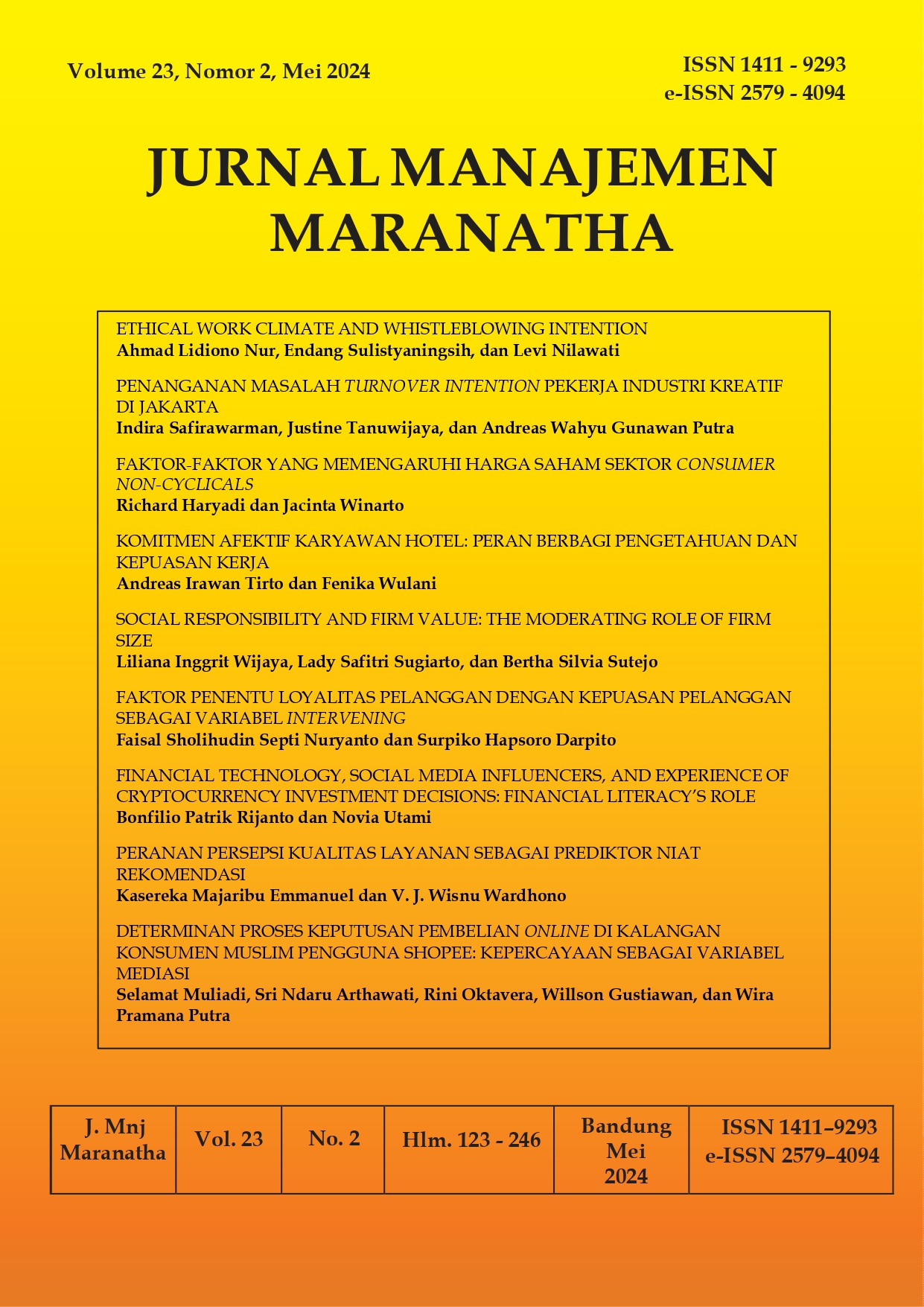Financial technology, social media influencers, and experience of cryptocurrency investment decisions: Financial literacy’s role
Main Article Content
Abstract
Downloads
Article Details

This work is licensed under a Creative Commons Attribution-NonCommercial 4.0 International License.
References
Alt, R., Beck, R., & Smits, M. T. (2018). FinTech and the transformation of the financial industry. In Electronic markets (Vol. 28, pp. 235–243). Springer. https://doi.org/10.1007/s12525-018-0310-9
Awais, M., Laber, M. F., Rasheed, N., & Khursheed, A. (2016). International Journal of Economics and Financial Issues Impact of Financial Literacy and Investment Experience on Risk Tolerance and Investment Decisions: Empirical Evidence from Pakistan. International Journal of Economics and Financial Issues, 6(1), 73-79. https://doi.org/ 10.1080/09645290110086126
Bank Indonesia. (2017). Peraturan Bank Indonesia nomor 19/PBI/2017 tentang penyelenggaraan teknologi finansial. https://www.bi.go.id/id/publikasi/peraturan/Pages/pbi_191217.aspx
Buchak, G., Matvos, G., Piskorski, T., & Seru, A. (2018). Fintech, regulatory arbitrage, and the rise of shadow banks. Journal of Financial Economics, 130(3), 453-483. https://doi.org/10.1016/j.jfineco.2018.03.011
Chairunnisa, A., & Dalimunthe, Z. (2021). Indonesian stock’s influencer phenomenon: Did financial literacy on millennial age reduce herding behavior? Jurnal Akuntansi Dan Keuangan, 23(2), 62-68. https://doi.org/10.9744/jak.23.2.62-68
Fachrudin, K. R., & Fachrudin, K. A. (2016). The influence of education and experience toward investment decision with moderated by financial literacy. Polish Journal of Management Studies, 14. 10.17512/pjms.2016.14.2.05
Fujiki, H. (2021). Crypto asset ownership, financial literacy, and investment experience. Applied Economics, 53(39), 4560-4581. https://doi.org/10.1080/00036846.2021.1904125
Hasani, M. N., Ramadhan, M., Mariyani, K., Setiawan, R., & Sucidha, I. (2022). Analisis cryptocurrency sebagai alat alternatif dalam berinvestasi di indonesia pada mata uang digital bitcoin. Jurnal Ilmiah Ekonomi Bisnis, 8(2), 329-344. https://doi.org/10.35972/jieb.v8i2.762
Huston, S. J. (2010). Measuring financial literacy. Journal of Consumer Affairs, 44(2), 296-316. https://doi.org/10.1111/j.1745-6606.2010.01170.x
Ismail, S., Nair, R. K., Sham, R., & Wahab, S. N. (2018). Impacts of online social media on investment decision in Malaysia. Indian Journal of Public Health Research & Development, 9(11). https://doi.org/ 10.5958/0976-5506.2018.01627.3
Jonathan, R., & Sumani, S. (2021). Millennial investment decision analysis. Business and Entrepreneurial Review, 21(2), 279-296. http://dx.doi.org/10.25105/ber.v21i2.10409
Junianto, Y., Kohardinata, C., & Silaswara, D. (2020). Financial literacy effect and Fintech in investment decision making. Primanomics: Jurnal Ekonomi & Bisnis, 18(3), 150-168. https://doi.org/10.31253/pe.v18i3.472
Khanam, Z. (2017). The impact of demographic factors on the decisions of investors during dividend declaration: A study on dhaka stock exchange, bangladesh. IOSR Journal of Business and Management (IOSR-JBM), 19(8), 1-7. https://doi.org/10.9790/487X-1908040107
Kotler, P., & Keller, K. L. (2012). Marketing management. Pearson
Kusumahadi, T. A., & Utami, N. (2022). Teknologi finansial, literasi keuangan, dan keputusan investasi produk reksa dana di Indonesia. Jurnal Manajemen Maranatha, 21(2), 177-186. https://doi.org/10.28932/jmm.v21i2.4631
Lee, I., & Shin, Y. J. (2018). Fintech: Ecosystem, business models, investment decisions, and challenges. Business Horizons, 61(1), 35-46. https://doi.org/10.1016/j.bushor.2017.09.003
Leong, K., & Sung, A. (2018). Fintech (financial technology): What is it and how to use technologies to create business value in Fintech way? International Journal of Innovation, Management and Technology, 9(2), 74-78. https://doi.org/10.18178/ijimt.2018.9.2.791
Liu, X. F., Jiang, X.-J., Liu, S.-H., & Tse, C. K. (2021). Knowledge discovery in cryptocurrency transactions: A survey. Ieee Access, 9, 37229-37254. https://doi.org/10.1109/ACCESS.2021.3062652
Luo, D., Mishra, T., Yarovaya, L., & Zhang, Z. (2021). Investing during a Fintech revolution: Ambiguity and return risk in cryptocurrencies. Journal of International Financial Markets, Institutions and Money, 73, 101362. https://doi.org/10.1016/j.intfin.2021.101362
Lusardi, A., & Mitchell, O. S. (2017). How ordinary consumers make complex economic decisions: Financial literacy and retirement readiness. Quarterly Journal of Finance, 7(03), 1750008. https://doi.org/10.1142/S2010139217500082
Madey, R. S. (2017). A study of the history of cryptocurrency and associated risks and threats. Utica College
Marwick, A. E. (2015). Instafame: Luxury selfies in the attention economy. Public Culture, 27(1), 137-160. https://doi.org/10.1215/08992363-2798379
Nugraheni, N. N. A., Kellen, P. B., & de Rozari, P. E. (2021). The effect of financial behavior, financial literacy, and macroeconomics on stock investment decision-making in East Nusa Tenggara. Annals of Management and Organization Research, 3(1), 1-20. https://doi.org/10.35912/amor.v3i1.1183
OECD. (2018). OECD/INFE toolkit for measuring financial literacy and financial inclusion. https://www.oecd.org/financial/education/2018-INFE-FinLit-Measurement-Toolkit.pdf
Okello Candiya Bongomin, G., Ntayi, J. M., Munene, J. C., & Nkote Nabeta, I. (2016). Social capital: Mediator of financial literacy and financial inclusion in rural Uganda. Review of International Business and Strategy, 26(2), 291-312. https://doi.org/10.1108/RIBS-06-2014-0072
Otoritas Jasa Keuangan. (2021). Strategi Nasional Literasi Keuangan Indonesia (SNLKI) 2021-2025. https://www.ojk.go.id/id/berita-dan-kegiatan/publikasi/Documents/Pages/Strategi-Nasional-Literasi-Keuangan-Indonesia-2021-2025/Strategi Nasional Literasi Keuangan Indonesia 2021-2025.pdf
Otoritas Jasa Keuangan. (2022). Survei Nasional Literasi dan Inklusi Keuangan 2022. https://Sikapiuangmu.Ojk.Go.Id/FrontEnd/CMS/InfoGraphics/16
Pernice, I. G. A., & Scott, B. (2021). Cryptocurrency. Internet Policy Review, Glossary of Decentralised Technosocial Systems, 10(2). https://doi.org/10.14763/2021.2.1561
Sangwan, V., Prakash, P., & Singh, S. (2020). Financial technology: A review of extant literature. Studies in Economics and Finance, 37(1), 71-88. https://doi.org/10.1108/SEF-07-2019-0270
Senft, T. M. (2013). Microcelebrity and the branded self. A Companion to New Media Dynamics, 346-354. https://doi.org/10.1002/9781118321607
Stolper, O. A., & Walter, A. (2017). Financial literacy, financial advice, and financial behavior. Journal of Business Economics, 87, 581-643. https://doi.org/10.1007/s11573-017-0853-9
Subash, R. (2012). Role of behavioral finance in portfolio investment decisions: Evidence from India. Charles University in Prague Faculty of Social Sciences Institute of Economic Studies. https://www.semanticscholar.org/paper/Role-of-Behavioral-Finance-in-Portfolio-Investment-Subash/a25b064af188dedd6d4a1d2b38a5f4c403e698fb
Ulmi, A. T., Pahlevi, C., & Sobarsyah, M. (2022). The influence of social media influencer on students’ interest in investing in the capital market. Hasanuddin Journal of Business Strategy, 4(1), 25-31. https://doi.org/10.26487/hjbs.v4i
Utami, N., & Sitanggang, M. L. (2021). The analysis of financial literacy and its impact on investment decisions: A study on generation Z in Jakarta. Inovbiz: Jurnal Inovasi Bisnis, 9(1), 33-40. https://doi.org/10.35314/inovbiz.v9i1.1840
We Are Social. (2022). Ownership of cryptocurrency. https://wearesocial.com/uk/blog/2022/01/digital-2022-another-year-of-bumper-growth-2/
World Economic Forum. (2017). Beyond Fintech: A pragmatic assessment of disruptive potential in financial services. https://www3.weforum.org/docs/Beyond_Fintech_-_A_Pragmatic_Assessment_of_Disruptive_Potential_in_Financial_Services.pdf
Zhao, H., & Zhang, L. (2021). Financial literacy or investment experience: Which is more influential in cryptocurrency investment? International Journal of Bank Marketing, 39(7), 1208-1226. https://doi.org/10.1108/IJBM-11-2020-0552

